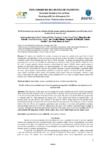Use este identificador para citar ou linkar para este item:
http://www.alice.cnptia.embrapa.br/alice/handle/doc/975459| Título: | Perfil da textura da carne de cordeiros de dois grupos genéticos alimentados com diferentes níveis de inclusão de casca de soja. |
| Autoria: | MORO, A. B.  WOMMER, T. P.   GALVANI, D. B.   PIRES, C. C.   LOPES, J. F.   PELLEGRIN, A. C. R. S. de   GRIEBLER, L.   SOUZA, A. P. B. de   |
| Afiliação: | ANDERSON BORTOLUZZI MORO, Graduação - Universidade Federal de Santa Maria (UFSM) - Santa Maria, RS, Brasil TATIANA PFÜLLER WOMMER, Pós-graduação - UFSM DIEGO BARCELOS GALVANI, CNPC CLEBER CASSOL PIRES, UFSM JUSECLÉIA FERREIRA LOPES, Pós-graduação - UFSM ANA CAROLINA RIBEIRO SANQUETTA DE PELLEGRIN, Pós-graduação - UFSM LETIERI GRIEBLER, Pós-graduação - UFSM ANA PAULA BINATO DE SOUZA. |
| Ano de publicação: | 2013 |
| Referência: | In: CONGRESSO BRASILEIRO DE ZOOTECNIA, 23., 2013, Foz do Iguaçu. Zootecnia do futuro: Produção Animal Sustentável: [anais]. Foz do Iguaçu: Universidade Estadual do Oeste do Paraná, 2013. |
| Conteúdo: | Resumo: O objetivo do trabalho foi avaliar a textura da carne de cordeiros da raça Texel e Ideal alimentados com diferentes níveis de casca de soja na dieta. Foram utilizados 40 cordeiros machos não castrados, sendo 20 provenientes da raça Texel e 20 da raça Ideal. As dietas corresponderam a diferentes proporções de casca de soja (% MS) em substituição ao volumoso: (0%; 33,5%; 66,5% e 100% de casca de soja). O grupo genético afetou somente a elasticidade da carne (P<0,05), sendo superior para os animais da raça Ideal demostrando ser aproximadamente 9% mais elástica que a carne de cordeiros Texel. Os níveis de inclusão de casca de soja na dieta afetaram a dureza, gomosidade e mastigabilidade da carne, apresentando comportamento quadrático e ponto de máxima no nível de 66,5%, tornando a carne menos suculenta, menos macia, necessitando assim, maior força na mastigação. Embora a raça afete a elasticidade da carne, assim como a dieta contendo 66,5% de casca de soja as outras variáveis da textura, esses valores não depreciam a carne. ]Profile of the texture of lamb meat from two genetic groups fed with different inclusion levels of soybean hulls]. Abstract: The objective of this study was to evaluate the texture of lamb meat of the Texel breed and the Ideal breed fed with different levels of soybean hulls on the diet. Forty uncastrated male lambs, 20 from of the Texel breed and 20 from of the Ideal breed were used. The diets consisted of different proportions of soybean hulls (% DM) replacing the forage: (0%, 33.5%, 66.5% and 100% of soybean hulls). The genetic group has just affected the elasticity of the meat (P <0.05), being higher for the animals Ideal breed demonstrating to be about 9% more elastic than Texel lambs meat. The inclusion levels of soybean hulls in the diet affected the toughness, gumminess and chewiness of the meat, with quadratic response and maximum point at level of 66.5%, making meat less juicy, less softness, requiring bigger strength in chewing. Although the breed has affected the elasticity of the meat, even as the diet containing 66.5% of soybean hulls affecting other variables of the texture, these values didn?t depreciate the lamb?s meat. |
| Thesagro: | Ovino Cordeiro Carne Dieta Resíduo Subproduto Alimento para animal Qualidade Elasticidade |
| NAL Thesaurus: | Meat quality Sheep Diet Lamb meat Mutton soybean hulls |
| Palavras-chave: | Subproduto agroindustrial Alimentação animal Casca de soja Maciez Softness Raça Ideal Raça Texel Elasticity Foods for animals |
| Notas: | ZOOTEC 2013 |
| Tipo do material: | Artigo em anais e proceedings |
| Acesso: | openAccess |
| Aparece nas coleções: | Artigo em anais de congresso (CNPC)  |
Arquivos associados a este item:
| Arquivo | Descrição | Tamanho | Formato | |
|---|---|---|---|---|
| aacPerfildatexturadacarnedecordeiros.pdf | 420,26 kB | Adobe PDF |  Visualizar/Abrir |









